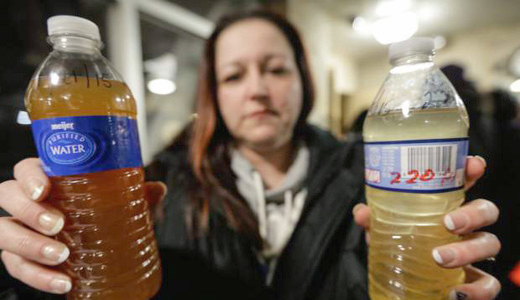
As the ongoing water crisis in Flint, Michigan has shown us, lead poisoning in water is not just an environmental issue; it is a matter of irresponsibility, and an infrastructure emergency. The question, then, is whether the Flint disaster is merely a symptom of a much broader problem. All over the country, communities are forced to live with tainted water, and it’s important to note that in many such cases, in the face of dire health concerns, states exhibit a shocking level of negligence.
It’s the sort of negligence in which people’s lives and wellbeing hang in the balance, as demonstrated when Michigan GOP Gov. Rick Snyder assigned a state-controlled “emergency manager” to make decisions regarding Flint water; the “manager,” Darnell Earley, ultimately failed to manage much of anything when he ruled that citizens should drink the city’s lead-tainted water. What’s a little widespread illness and death, one could wonder, when such a measure saves the city $5 million over two years? It’s this sort of thinking that dictates the terms of environmental and infrastructural management in other states, especially those largely run by Republicans.
This corruption has manifested also throughout small, rural towns in Texas, where 82,000 state residents have tested positive for high levels of arsenic, because their water sources are tainted with the stuff. And “state officials have told [those] people they don’t need to find an ‘alternative water supply’,” according to the Environmental Integrity Project, which released a recent report tracking the violations of Safe Drinking Water standards and criticizing the lack of response or preventative action by state officials. The report noted that “drinking water systems serving 51,000 people in 34 Texas communities have violated the Safe Drinking Water standard for arsenic, a potent carcinogen, for more than a decade, but state health advisories continue to insist that the water is safe to drink.”
Over in Flint, it was children who paid the steepest price for consuming poisoned water, and according to the city’s pediatric physician Dr. Mona Hanna-Attisha, “it causes irreversible damage. It can impact IQ and behavior. You don’t mess around with lead.” That situation is being replicated time and again, right under our noses, in schools all over the U.S. On Mar. 4, lead was detected for the second time in a middle school in Healdsburg, California, due to “a problem with lead levels in the drinking water,” according to district superintendent Chris Vanden Heuvel. The first incident occurred in a local elementary school.
There is currently no government-approved recommendation to check for lead-contaminated water when children are found to have lead in their blood. The current screening protocols don’t look at poisoning from water sources, but rather, focus entirely on matters like lead paint exposure. But much of the problem today lies in the pipes, not the walls. “Any [pre-1990s] building is a candidate for deterioration in the plumbing system, given the construction materials they used,” said Heuvel.
“Lead paint is of course still a problem, but I don’t think we’ve been producing any of it for years,” said Tom Shepherd, member of the Chicago-based Southeast Environmental Task Force and the Sierra Club. He told the People’s World, “At this point, the more critical issue is the lead in the water. Who would want to drink something that comes from that water in Flint?” The same goes for other communities, he added. “Look at the Grand Calumet River in west Indiana, where factories are dumping right into the water.” These types of poisonings, he noted, are the ones that are widespread and dangerous to children.
Lead toxicity in water, however, is not solely to blame. It is often a product of greed-motivated officials simply turning a blind eye to drinking water – and decrepit infrastructure. “In Chicago,” said Shepherd, “they realized years back that all these homes still had lead pipes. Our previous mayor, Daley, he used to talk a lot about water conservation. And then, of course, came the water department guys telling the residents to let their water run for 10 minutes before use because of the contaminated pipes. So there was quite a discrepancy.”
The Flint crisis in particular served as a sobering reminder that U.S. infrastructure is falling apart; the American Society of Civil Engineers found that the approximate cost of fixing lead pipes, unsafe school buildings, mass transit systems, hazardous waste issues, and bridges would amount to roughly $3.6 trillion by 2020. And state Republicans – very much like Gov. Snyder – see those price tags as barriers, not motivators.
“We’re supposed to depend on our public officials, but there’s no accountability,” Shepherd added. “This is going on now in states where tea party Republican governors take power. And these elected officials get their own [corrupt] people into the Departments of Public Works and Departments of Water Resources.”
But the issue extends far beyond corruption on a state-by-state basis; Congress has been urged time and again to act on a job-creating infrastructure bill, but has opted instead for obstructionism in the face of any move to pass meaningful legislation that could literally save lives – lives like those in Flint, throughout Texas, and in towns like Healdsburg.
“And this isn’t just happening in impoverished areas,” Shepherd concluded. “The wealthy ought to be concerned too. Water contamination isn’t just something that happens to the poor, it’s not even something that just happens in the states. It’s a worldwide problem.”
Photo: Tragedies involving water contamination like the ongoing one in Flint, Michigan, are occurring in many other parts of the country due to outdated infrastructure, corruption or inaction on the part of elected officials, and outdated, crumbling infrastructure. Detroit Free Press | AP










